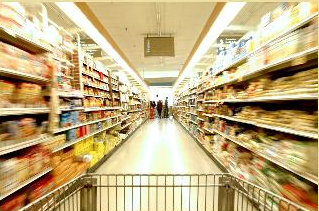Food packaging is a shallow industry. If everyone’s favorite packaged foods held a beauty pageant, there would be no honorable mention for inner beauty. While package design serves the function of protecting your food, the objective of effective design is always to attract the right attention.
For brands and the designers they hire, effective design means appropriate and engaging communication. Food is a low-involvement purchase with often only small ingredients differentiating a product. You say tomato, I say to-mah-to, but when buying groceries, package design influences which of the same or similar products will end up in the customer’s basket. (Whether we’re ready to accept the tomato as a fruit is another story).
Candy Land: The Game of Capturing the Customer’s Attention
 The modern supermarket is a fantasy land of unlimited choices and impulsive behavior (did you really need the six bags of frozen pierogi). Actually, though supermarkets abound with options, the modern consumer, on average, doesn’t spend much per trip. According to the Food Marketing Institute (FMI), US supermarkets held 38,718 items per store with an average checkout total of $27.18 per customer in 2010. To further complicate that, customers process the image of the products they pass by in just 1/10th of a second. Suddenly the critical considerations of food package design have come into focus.
The modern supermarket is a fantasy land of unlimited choices and impulsive behavior (did you really need the six bags of frozen pierogi). Actually, though supermarkets abound with options, the modern consumer, on average, doesn’t spend much per trip. According to the Food Marketing Institute (FMI), US supermarkets held 38,718 items per store with an average checkout total of $27.18 per customer in 2010. To further complicate that, customers process the image of the products they pass by in just 1/10th of a second. Suddenly the critical considerations of food package design have come into focus.
Back in June 2011, the Envision team identified three ways package design has power over the customer’s purchase choices in the blog post “The Power of Packaging Design”. When buying food and other similar products, customers are influenced by 1-Desire, 2-Brand Recognition, Image, and Loyalty, and 3- Convenience and Price. Though price and convenience are essential elements for products and 70% of purchase decisions are made at the shelf, carefully directedemotions can outweigh the benefits of higher convenience and lower price.
New Products: Communicate Benefits

With so many new dieting fads and associated products, how might a designer help get food off the shelves and into baskets? New products must, first of all, capture all the benefits, attributes, and unique (differentiating) factors of the food item. One problem marketers face with new food products is communicating health benefits. The FDA recently begun regulating so-called Better for You and Functional Foods by mandating “qualified health claims.” Items making claims that do not meet SSA or “significant scientific agreement” on their benefits, such as “will lower risk of lung cancer” or “helps maintain healthy blood pressure.” Marketers, healthcare professionals, and food industry people expect qualified claims to be an increasing trend.
The Emotional Appeal of Food Packaging
Grocery shopping might not be as emotional as daytime soap opera (though the price of turnips has been known to induce a tear or two), but the choice of products based on package design is indeed guided by the emotions. The key asset of any food company’s offerings is its brand identity. This is the emotional appeal of the tangible product. The current brand identity and brand elements (logo, color, slogan, mascots, etc) must inform any choices for packaging visuals and color schemes. Though the choice of color might depend on the brand’s logo color, this is an aspect of design that should never be neglected. For ideas on color choice, consider the emotional perception of different colors, beautifully explained in this info-graphic from printmediacentr.com. The brand not only speaks to the company values, but also the values of their target consumer, though brand loyalty can easily sway with low-involvement decisions like choosing a can of beans. Improvements in design tools and software have made designing competition even more intense, but also better.
Who Spilled the Beans? Analysis: No Name Brand
Speaking of beans, I’d like to draw your attention to a peculiar case in both branding and food packaging design.
 Founded in 1978 by Loblaws’ Companies (Canada’s largest food retailer), No Name Brand began a trend of supposedly un-branded products. Instead of offering an emotional appeal, No Name (or Sans Nom for all the Francophiles in the house) offered transparency in an industry known for exaggeration. More importantly, their emphasis was on low price. When p eople buy this can of beans, they know exactly what they are getting – a can of beans in tomato sauce. The color yellow is also often used to indicate low price. So is this an effective strategy to attract the highly-distracted consumer’s attention? Is this truly an unbranded product, or does the package design communicate something more than the product inside the can? Would love to hear our reader’s thoughts.
Founded in 1978 by Loblaws’ Companies (Canada’s largest food retailer), No Name Brand began a trend of supposedly un-branded products. Instead of offering an emotional appeal, No Name (or Sans Nom for all the Francophiles in the house) offered transparency in an industry known for exaggeration. More importantly, their emphasis was on low price. When p eople buy this can of beans, they know exactly what they are getting – a can of beans in tomato sauce. The color yellow is also often used to indicate low price. So is this an effective strategy to attract the highly-distracted consumer’s attention? Is this truly an unbranded product, or does the package design communicate something more than the product inside the can? Would love to hear our reader’s thoughts.
Next time, we put these food packaging thoughts into play as we discuss different approaches to wine label design.
-FINAL(01-00)-White&Blue-01.svg)




